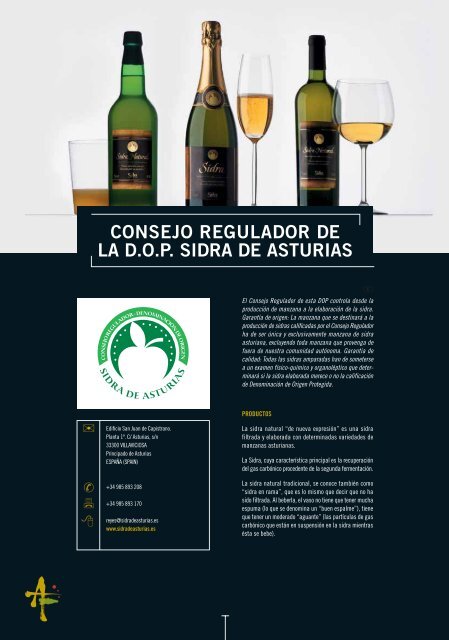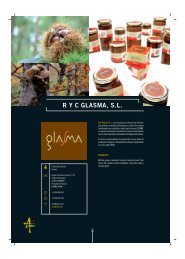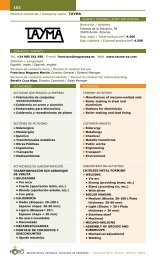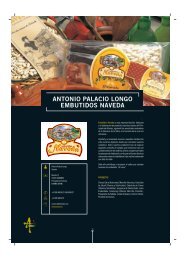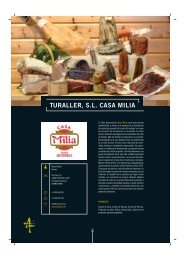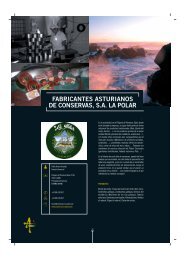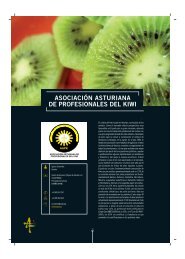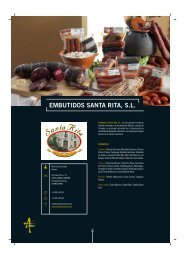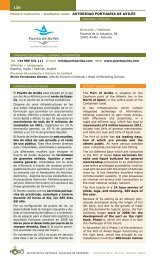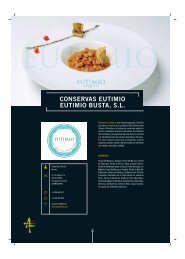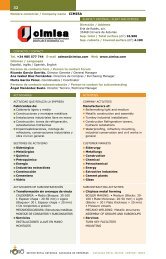consejo regulador de la dop sidra de asturias - Asturex
consejo regulador de la dop sidra de asturias - Asturex
consejo regulador de la dop sidra de asturias - Asturex
Create successful ePaper yourself
Turn your PDF publications into a flip-book with our unique Google optimized e-Paper software.
CONSEJO REGULADOR DE<br />
LA D.O.P. SIDRA DE ASTURIAS<br />
El Consejo Regu<strong>la</strong>dor <strong>de</strong> esta DOP contro<strong>la</strong> <strong>de</strong>s<strong>de</strong> <strong>la</strong><br />
producción <strong>de</strong> manzana a <strong>la</strong> e<strong>la</strong>boración <strong>de</strong> <strong>la</strong> <strong>sidra</strong>.<br />
Garantía <strong>de</strong> origen: La manzana que se <strong>de</strong>stinará a <strong>la</strong><br />
producción <strong>de</strong> <strong>sidra</strong>s calificadas por el Consejo Regu<strong>la</strong>dor<br />
ha <strong>de</strong> ser única y exclusivamente manzana <strong>de</strong> <strong>sidra</strong><br />
asturiana, excluyendo toda manzana que provenga <strong>de</strong><br />
fuera <strong>de</strong> nuestra comunidad autónoma. Garantía <strong>de</strong><br />
calidad: Todas <strong>la</strong>s <strong>sidra</strong>s amparadas han <strong>de</strong> someterse<br />
a un examen físico-químico y organoléptico que <strong>de</strong>terminará<br />
si <strong>la</strong> <strong>sidra</strong> e<strong>la</strong>borada merece o no <strong>la</strong> calificación<br />
<strong>de</strong> Denominación <strong>de</strong> Origen Protegida.<br />
PRODUCTOS<br />
Edificio San Juan <strong>de</strong> Capistrano.<br />
P<strong>la</strong>nta 1ª. C/ Asturias, s/n<br />
33300 VILLAVICIOSA<br />
Principado <strong>de</strong> Asturias<br />
ESPAÑA (SPAIN)<br />
+34 985 893 208<br />
+34 985 893 170<br />
reyes@<strong>sidra</strong><strong>de</strong><strong>asturias</strong>.es<br />
www.<strong>sidra</strong><strong>de</strong><strong>asturias</strong>.es<br />
La <strong>sidra</strong> natural “<strong>de</strong> nueva expresión” es una <strong>sidra</strong><br />
filtrada y e<strong>la</strong>borada con <strong>de</strong>terminadas varieda<strong>de</strong>s <strong>de</strong><br />
manzanas asturianas.<br />
La Sidra, cuya característica principal es <strong>la</strong> recuperación<br />
<strong>de</strong>l gas carbónico proce<strong>de</strong>nte <strong>de</strong> <strong>la</strong> segunda fermentación.<br />
La <strong>sidra</strong> natural tradicional, se conoce también como<br />
“<strong>sidra</strong> en rama”, que es lo mismo que <strong>de</strong>cir que no ha<br />
sido filtrada. Al beber<strong>la</strong>, el vaso no tiene que tener mucha<br />
espuma (lo que se <strong>de</strong>nomina un “buen espalme”), tiene<br />
que tener un mo<strong>de</strong>rado “aguante” (<strong>la</strong>s partícu<strong>la</strong>s <strong>de</strong> gas<br />
carbónico que están en suspensión en <strong>la</strong> <strong>sidra</strong> mientras<br />
ésta se bebe).
The Regu<strong>la</strong>tory Council of this P.D.O. controls and inspects<br />
the whole process from apple-growing to ci<strong>de</strong>r production.<br />
Guarantee of origin: The apple to be used for production<br />
of ci<strong>de</strong>rs as <strong>de</strong>scribed by the Regu<strong>la</strong>tory Council must<br />
be solely and exclusively Asturian ci<strong>de</strong>r apple, excluding<br />
all apples from outsi<strong>de</strong> our autonomous region. Quality<br />
assurance: All protected ci<strong>de</strong>rs must be subjected to a<br />
physical-chemical and organoleptic examination to<br />
<strong>de</strong>termine whether or not the ci<strong>de</strong>r produced merits<br />
Protected Designation of Origin certification.<br />
PRODUCTS<br />
Natural “new expression” ci<strong>de</strong>r is filtered and produced<br />
from particu<strong>la</strong>r varieties of Asturian apple.<br />
Sparkling ci<strong>de</strong>r, the main feature of wich is recovery of<br />
the carbonic gas from the second fermentation.<br />
Traditional Natural Ci<strong>de</strong>r, known also as ci<strong>de</strong>r “en rama”,<br />
wich means it has not been filtered. When the ci<strong>de</strong>r is<br />
being drunk, the g<strong>la</strong>ss should not contain much foam<br />
(this is known as having “buen espalme”, i.e. the foam<br />
disappears quickly); the ci<strong>de</strong>r should have mo<strong>de</strong>rate<br />
“aguante” (the length of time the carbonic gas particles<br />
reamin in suspension in the ci<strong>de</strong>r while it is being drunk).<br />
Le Conseil Régu<strong>la</strong>teur <strong>de</strong> cette DOP (Dénomination<br />
d’Origine Protégée) contrôle <strong>de</strong>puis <strong>la</strong> production <strong>de</strong> <strong>la</strong><br />
pomme jusqu’à l’é<strong>la</strong>boration du cidre. Garantie d’origine :<br />
La pomme qui est <strong>de</strong>stinée à <strong>la</strong> production <strong>de</strong> cidres<br />
qualifiés par le Conseil Régu<strong>la</strong>teur doit être uniquement<br />
et exclusivement une pomme <strong>de</strong> cidre asturienne, ceci<br />
excluant toute pomme qui ne proviendrait pas <strong>de</strong> notre<br />
communauté autonome. Garantie <strong>de</strong> qualité : Tous les<br />
cidres protégés doivent être soumis à un examen physique,<br />
chimique et organoleptique qui déterminera si le cidre<br />
é<strong>la</strong>boré mérite ou non <strong>la</strong> qualification <strong>de</strong> Dénomination<br />
d’Origine Protégée.<br />
PRODUITS<br />
Le cidre naturel «<strong>de</strong> nueva expresión» (nouvelle expression)<br />
est un cidre filtré et é<strong>la</strong>boré avec <strong>de</strong>s variétés <strong>de</strong><br />
pommes asturiennes déterminées.<br />
Le cidre, dont <strong>la</strong> caractéristique principale est <strong>la</strong> récupération<br />
du gaz carbonique provenant <strong>de</strong> <strong>la</strong> secon<strong>de</strong><br />
fermentation.<br />
Le cidre naturel traditionnel, connu aussi sous le nom<br />
<strong>de</strong> «<strong>sidra</strong> en rama» (cidre en branche), ce qui revient à<br />
dire qu’il n’a pas été filtré. En le buvant, le verre ne doit<br />
pas avoir beaucoup <strong>de</strong> mousse, (ce qu’on appelle un<br />
«buen empalme», «bon branchement»), il doit avoir un<br />
«aguante» (résistance) modéré (il s’agit <strong>de</strong>s particules<br />
<strong>de</strong> gaz carbonique qui sont en suspension dans le cidre<br />
pendant que l’on boit).


